Reserve Bank of Australia Annual Report – 1986 Financial Markets[*]
Financing
Australia's demands on capital markets increased in 1985/86. While there was little change in net public sector borrowing, there was a substantial increase in borrowing by the private sector. Growth in household savings failed to keep pace with credit demand. As a result, net borrowing from abroad increased for the third consecutive year. With monetary policy restrictive during most of the year, domestic interest rates were high, both in nominal terms and relative to the rate of inflation.
The 1985/86 Commonwealth Budget provided for a large reduction in the budget deficit to $4.9 billion, from $6.7 billion in 1984/85, and for a reduction in the net public sector borrowing requirement. In the event, mainly as a result of the lower-than-projected exchange rate and some expenditure overruns, the deficit for 1985/86 was $5.7 billion (2½ per cent of GDP). The net public sector borrowing requirement of around $13 billion was correspondingly larger than projected and, at 5¾ per cent of GDP, was little changed from the preceding year. (5)
The Commonwealth's gross borrowing abroad (denominated in foreign currencies) was $2.9 billion ($1.3 billion net of repayments) in 1985/86 compared with $1.8 billion ($0.9 billion net of repayments) in 1984/85. During the year, the Commonwealth took advantage of lower interest rates overseas to refinance some earlier borrowings. In addition to these refinancings, it raised the amounts shown in the table below.
| Announced | Currency | Net Proceeds ($Am) |
|---|---|---|
| 5 August '85 | Sterling | 179 |
| 17 October | Yen | 334 |
| 19 November | Guilders | 212 |
| 23 January '86 | U.S. dollars | 709 |
| 17 February | Deutschemarks | 319 |
5 Government Finance




6 Money and Credit Aggregates
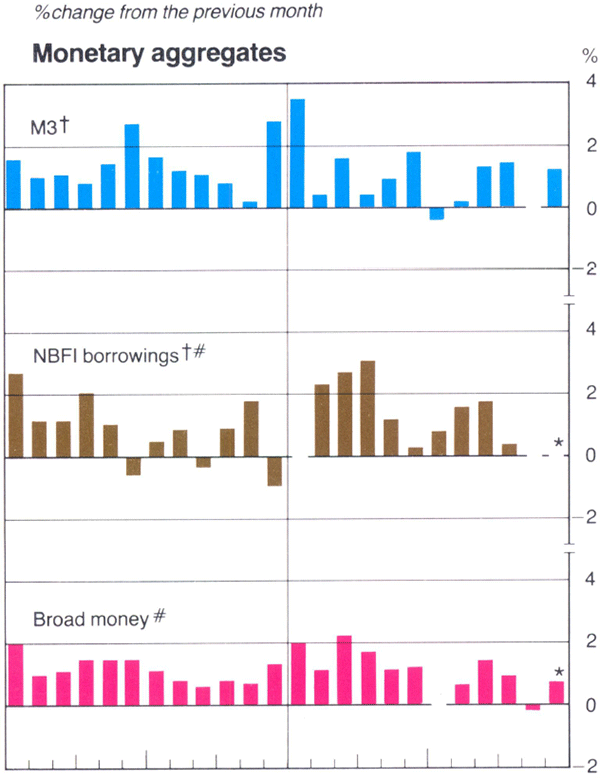
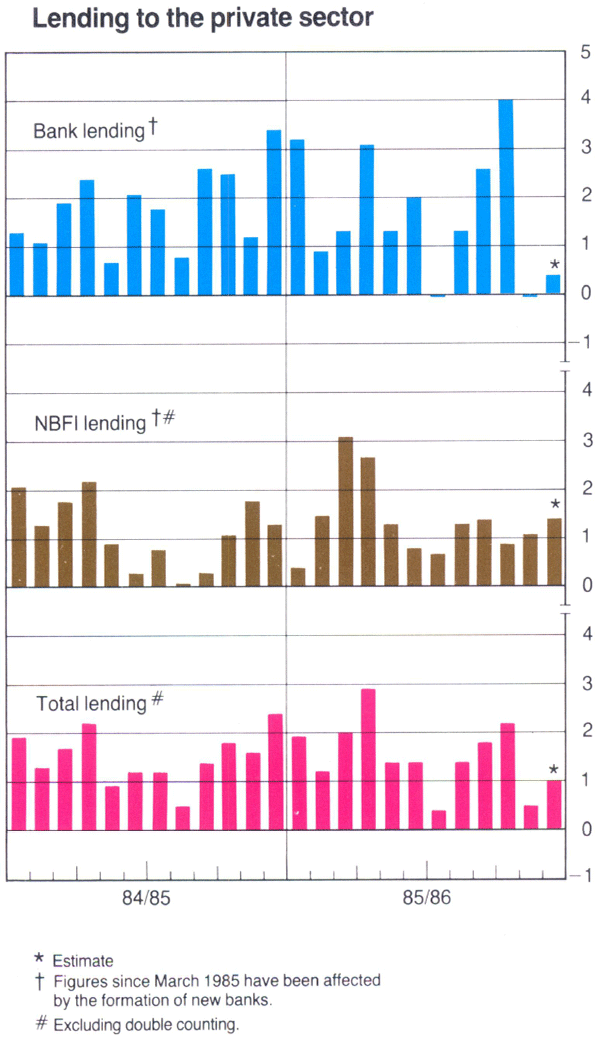
New raisings by local and semi-government authorities in 1985/86 were estimated at $8.2 billion, about $0.1 billion below the level in 1984/85. Of the total for 1985/86, approximately $1.9 billion was raised overseas.
As in most overseas markets, share prices in Australia rose strongly during the year; takeover activity was particularly high. Over the twelve months to June 1986, the “all ordinaries” index rose from 855 to 1211, an increase of 42 per cent.
Borrowing and lending by all financial intermediaries grew by around 13½ and 20 per cent respectively in the year to June 1986, compared with annual growth rates of 14.8 and 19.5 per cent respectively in the year to June 1985. Growth was very strong in the second half of 1985 but slowed in the first half of 1986. With strong growth in the economy in the early part of the year, the private sector's demand for credit was maintained at a high level. In addition, many intermediaries have responded to the financial deregulation of recent years by seeking to expand, or maintain, their market share. At least in the first half of the financial year, intermediaries appear to have continued to win business from various direct channels of financing.(6)
| Borrowing | Lending | |
|---|---|---|
| 1983/84 | 11.5 | 12.1 |
| 1984/85 | 14.8 | 19.5 |
| 1985/86(b) | 13.5 | 20.3 |
| 1985/86 | ||
| September Quarter | 5.6 | 5.1 |
| December Quarter | 3.9 | 5.8 |
| March Quarter | 2.0 | 3.6 |
| June Quarter(b) | 1.4 | 4.4 |
| (a) Excludes the effects of transactions between non-bank financial intermediaries,
identifiable from July 1984. (b) Preliminary. |
||
Lending by banks continued to grow more strongly than lending by non-bank financial intermediaries. This divergence was more than accounted for by the commencement of new banks and the transfer of assets and liabilities to them from non-banks.
In the year to June 1986, M3 grew by 13.0 per cent. The twelve-months-ended growth rate of M3 had peaked in the second half of 1985 at 19.7 per cent. The slowdown in growth in the first half of 1986 reflected the slowdown in the overall pace of intermediation; it also reflected the pattern of establishment of new banks over the past year and a half. Growth of broad money (on the same basis) also slowed in the second half of the year, from around 16 per cent in the year to October to around 13½ per cent in the year to June 1986.
Lending by financial intermediaries to the private sector rose by 20 per cent in 1985/86, about the same as in 1984/85.
Lending to households slowed from around late 1985; in the year to June 1986, it rose by 13 per cent compared with 18½ per cent over 1984/85. Growth in lending for housing slowed in the December and March quarters of 1985/86, when ceilings on interest rates charged by the main lending institutions, combined with rising market rates, curbed the supply of finance for housing. In the June quarter, following introduction of a housing assistance package which enabled savings banks to compete more effectively for deposits, the growth in bank housing loan approvals picked up. For the year as a whole, the growth of lending for housing was 4 percentage points lower than in the previous year. Growth in lending to persons other than for housing slowed by about 7 percentage points.
| To Private Sector | To Public Sector | |||||||
|---|---|---|---|---|---|---|---|---|
| Housing | Other Personal |
Other (a) (mainly to business) |
||||||
| $b |
% change |
$b |
% change |
$b |
% change |
$b |
% change |
|
| 1983/84 | 3.4 | 12.4 | 2.6 | 18.4 | 5.6 | 10.2 | 3.6 | 17.9 |
| 1984/85 | 5.4 | 17.7 | 3.4 | 19.8 | 11.6 | 20.3 | 1.7 | 7.1 |
| 1985/86 (b) | 4.8 | 13.5 | 2.7 | 13.0 | 17.9 | 25.9 | 1.2 | 4.6 |
|
(a) Excludes the effects of transactions between non-bank financial intermediaries,
identifiable from July 1984. (b) Preliminary |
||||||||
Other lending to the private sector by financial intermediaries, mainly to business, rose by 26 per cent in the year to June 1986, about 6 percentage points faster than in 1984/85. This strong outcome might have been boosted by the substantial amount of takeover activity in the second half of the year. Also during this period, intermediaries increased their holdings of private sector marketable securities (which are included in “other” lending). Over the year as a whole, intermediaries increased their holdings of bank bills by almost $4 billion (55 per cent). Holdings of bills by the non-finance sector rose by over $5 billion (about 45 per cent), following a rise of $3½ billion in 1984/85.(7)
Borrowing by financial intermediaries continued to grow strongly until late 1985, but then moderated. The gap between the rates of growth of borrowing and lending by intermediaries in 1985/86 was the result of several factors. These included:
- slow growth in lending by intermediaries to the public sector. In part, this was a result of savings banks and building societies reducing their holdings of government securities to fund housing loans. In addition, trading banks were permitted to hold a lower portion of their assets in Commonwealth Government securities under the PAR arrangements phased in between June 1985 and March 1986;
- a strong increase in banks' capital, including around $1.6 billion associated with the entry of new banks. These funds are not a part of borrowing but nevertheless are available for investment and lending; and
- an increase in overseas borrowing by financial intermediaries in both foreign currencies and Australian dollars, to fund lending in Australia. For banks, foreign currency liabilities, net of foreign currency assets, rose by $1.6 billion in 1985/86. For non-bank financial intermediaries, net borrowing from non-residents rose by $2.0 billion.
7 Indicators of Financial Conditions
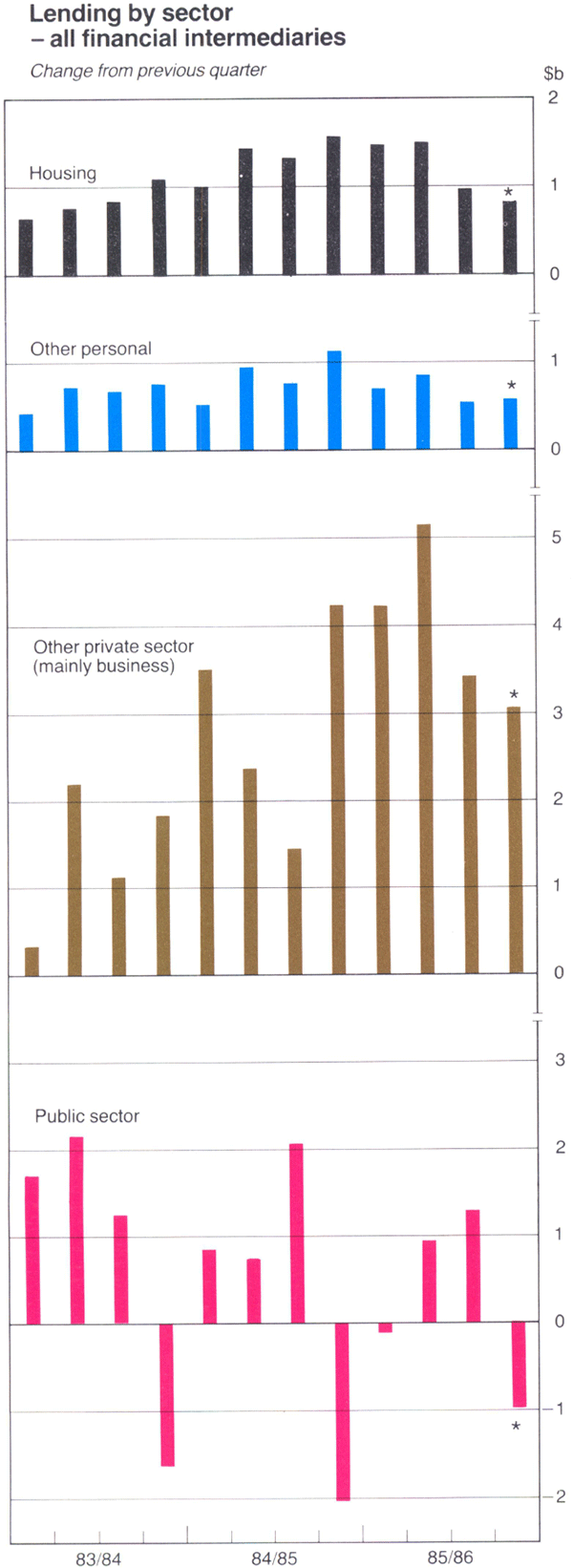
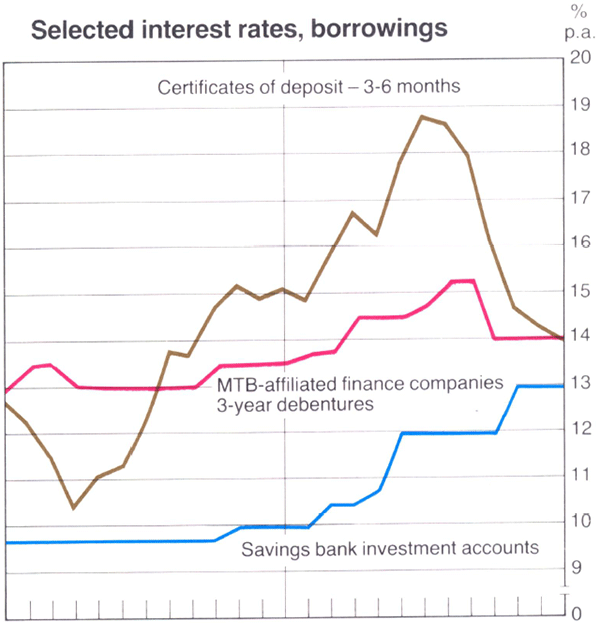
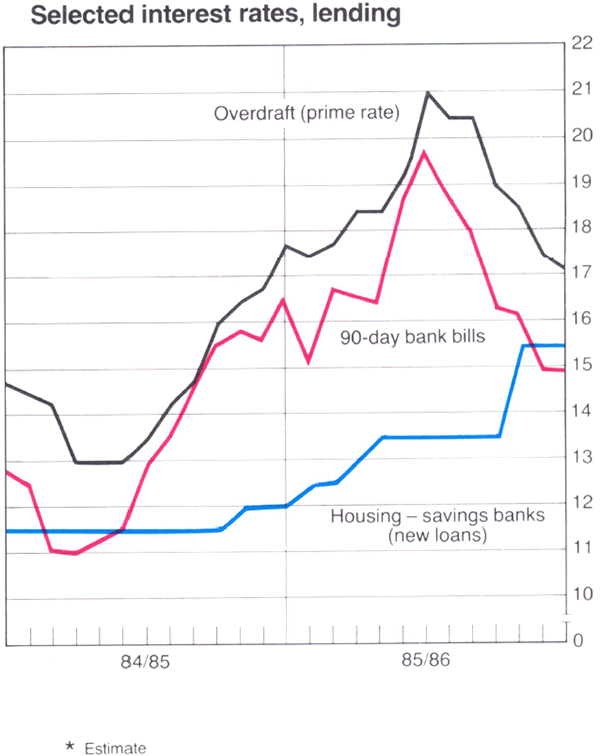
Financial Intermediaries
Bank lending grew faster than that of non-bank financial intermediaries in 1985/86 although the reverse was true of borrowing. Comparison of the growth of banks and non-banks has been distorted since early 1985 by the commencement of new banks, many of which transferred assets and liabilities from their non-bank affiliates. There were 19 new banks established in 1985/86, bringing the total number of new banks established since March 1985 to 21. Over 1985/86 as a whole, new banks established during the year accounted for 4 percentage points of growth in bank deposits and 6 percentage points of growth in bank lending.
| Deposits/Borrowings | Lending | |||
|---|---|---|---|---|
| Banks | NBFIs(b) | Banks | NBFIs(b) | |
| 1982/83 | 12.9 | 11.0 | 13.0 | 8.4 |
| 1983/84 | 10.5 | 11.5 | 12.5 | 12.2 |
| 1984/85 | 17.8 | 10.6 | 24.0 | 14.8 |
| 1985/86 | 13.4 | 14.6(c) | 22.3 | 18.7(c) |
|
(a) Figures are influenced by the transfer of assets and liabilities to new banks. (b) Excludes the effects of transactions between non-bank financial intermediaries, identifiable from July 1984. (c) Preliminary |
||||
Trading banks competed aggressively during the first half of 1985/86, as existing banks were spurred by the imminent entry of new banks; they took advantage of the greater freedom arising from deregulation to meet strong demand for credit. There was some easing in the demand for credit in the latter part of the financial year, no doubt reflecting high levels of interest rates as well as a slowing in economic growth. During this period, some banks' participation in the financing of share market activity helped boost their balance sheets.
Savings banks grew slowly over the year as a whole. Within the year, there was modest inflow of deposits in the first half, and an outflow in the March quarter. On 2 April, the Government introduced a housing package to increase the competitiveness of savings banks. The main ingredient of this package was the removal of the interest rate ceiling from bank housing loans (of less than $100,000 for owner-occupation) approved from 3 April 1986. The Government also agreed to provide a subsidy to assist savings banks to compete more effectively for deposits while still maintaining the ceiling on interest rates charged on existing loans. For their part, the banks undertook to increase their lending for housing in 1986/87. These measures induced growth in savings bank deposits, and new lending approvals for housing recovered sharply in the final months of the year.
State banks grew strongly in 1985/86. Over recent years, they have competed aggressively in domestic financial markets in a bid to enhance their market presence.
In December 1985, the shareholders of the Australian Resources Development Bank announced that, as a result of the deregulation of the Australian financial system, the bank had outlived its original purpose and its functions could now be fully serviced by the individual shareholder banks. As a consequence, the Bank and its export refinance subsidiary are being wound down. The shareholder banks have assured depositors and other lenders to the Bank that during the winding down period they will guarantee all existing and future borrowings within Australia and overseas.
Details of growth in borrowings and lending for the major groups are shown in the following table.
| 1983/84 | 1984/85 | 1985/86(b) | |
|---|---|---|---|
| Trading banks | |||
| Deposits | 6.5 | 25.0 | 15.5 |
| Lending | 10.7 | 23.8 | 23.3 |
| Savings banks | |||
| Deposits | 14.4 | 13.2 | 9.5 |
| Lending | 15.3 | 27.8 | 16.7 |
| Building societies | |||
| Borrowing | 15.9 | 3.4 | 8.0 |
| Lending | 16.3 | 5.6 | 10.9 |
| Finance companies | |||
| Borrowing | 4.0 | 15.9 | 10.1 |
| Lending | 6.2 | 14.4 | 9.7 |
| Money market corporations | |||
| Borrowing | 21.1 | 9.3 | 22.6 |
| Lending | 25.3 | 24.7 | 32.6 |
| Cash management trusts | |||
| Borrowing | −33.2 | 6.1 | 108.4 |
| Lending | −23.2 | −1.3 | 100.0 |
|
(a) Data cover borrowing from and lending to the private sector. Figures are influenced
by transfers of assets and liabilities to new banks and between non-bank
groups and by the establishment of new non-bank institutions. (b) Preliminary |
|||
Non-banks as a group grew at a faster pace in 1985/86 than in recent years. An exception was building societies. Their competitive position was affected, to varying degrees, by differing State government limitations on higher mortgage interest rates. There were also significant structural changes in the sector during the year. Some building societies transferred to the savings bank sector and there were several amalgamations of societies, including the merger of the two largest societies in Victoria; the transfer of building society business to new savings banks in 1985/86 reduced growth of building society borrowings by 5 percentage points following a reduction of 12 percentage points in 1984/85. Changes in the legislative framework applying to societies also occurred; by the end of 1985/86, all State governments had amended their building societies' legislation, enabling societies to diversify their lending portfolios, broaden their borrowing activities and strengthen their capital bases.
The growth of finance companies' balance sheets also slowed in 1985/86. They grew strongly in the first nine months of the year, supported by continued growth in household and business demand, but slowed in the June quarter. It appears that balance sheet expansion was achieved with some reduction in margins; higher loan loss experiences also reduced interim profits reported in the six months to March 1986.
The balance sheets of money market corporations (merchant banks) showed marked variations from month to month but their overall performance was relatively strong. This was despite increased competition from banks, the transfer of business to new banks and the tendency for some corporations to place greater emphasis on fee-based activities. Corporations established during the year made a major contribution to growth of the group. As in the previous year, money market corporations relied heavily on offshore borrowings to fund domestic lending.
Cash management trusts benefited from the rise in short-term interest rates during the year; units on issue more than doubled. In the latter months of the year, inflows slowed as trusts became less competitive following the declines in short-term interest rates.
Foreign Investment Regulations for Intermediaries
In October 1985, the Treasurer announced a general relaxation of the foreign investment requirements for non-bank financial intermediaries. As a result, investments of less than $10 million in such new businesses are not subject to examination and investment in new businesses of $10 million or more and/or takeovers of existing business may generally expect approval, unless considered contrary to the national interest. This announcement followed a period of twelve months during which merchant banks had been given a free hand to effect rationalisation and restructuring of their ownership. By end June 1986, the Government had approved 60 proposals for the establishment of new merchant banks; restructuring of the ownership of a further 22 existing entities was also approved. Of the 60 new merchant banks, more than half had commenced operations by June 1986.
Developments in Payment Arrangements
Cheques Bill 1986
A Cheques Bill was put before the Parliament in 1986. If enacted, it will revise and replace the provisions relating to cheques in the Bills of Exchange Act. The new legislation would not alter the fundamental legal character of cheques. A particular feature of the Bill is that it makes provision for truncation of cheques. Truncation involves the presentment of cheques by sending particulars — rather than the cheques themselves — from the collecting bank to the paying bank. As such, it provides an alternative means of cheque clearing.
Cheque clearing between banks
The entry of new banks has focused attention on arrangements in the cheque clearing system. In February 1985, members of the Australian Clearing House Association announced that new banks would have the option of participating directly in the clearing house or indirectly through agency arrangements with other banks. Banks seeking direct access are required, among other things, to pay an entrance fee for membership of the Clearing House Association. More recently, an annual participation fee has been proposed to provide for a more equitable distribution of the common operating costs — particularly transport costs — involved in the cheque clearing system. Distribution of the fee pool between banks will reflect each bank's contribution to the overall costs of running the system.
Australian Payments System Council
Last year's Annual Report provided background on the establishment of the Australian Payments System Council. The Council continued to meet regularly in 1985/86.
A matter of priority for the Council was the question of access by non-banks to the cheque clearing system. Such access is available through a growing number of arrangements between banks and building societies, and between banks and credit unions. Following recommendations by the Council, the Cheques Bill was amended in several important respects to facilitate these arrangements. Another of the Council's recommendations concerned payment orders and, consistent with that recommendation, the Government has indicated its intention to introduce legislation which would give payment orders essentially the same operational characteristics as cheques.
The Council has continued to monitor developments in electronic funds transfer (EFT) systems and to consider issues relevant to the sound development of these systems. In 1985/86 there were further moves towards interconnection of systems. Links are now operational between automatic teller machine systems and EFT point of sale (EFT POS) systems, and involve established banks, newly licensed banks and non-banks. Particular issues before the Council in 1985/86 included alternative EFT POS systems, technical standards, security and other protections for consumers.
| Total Assets ($m) in Australia* | ||
|---|---|---|
| 1985 | ||
| March | Macquarie Bank Limited | 562 |
| June | Advance Bank Australia Limited | 2,462 |
| September | CHASE AMP Bank Limited | 653 |
| October | Lloyds Bank NZA Limited | 513 |
| November | Bank of Tokyo Australia Limited | 245 |
| Barclays Bank Australia Limited | 344 | |
| December | Citibank Limited | 963 |
| Citibank Savings Limited | 145 | |
| Bank of China | 82 | |
| IBJ Australia Bank Limited | 227 | |
| 1986 | ||
| January | Mitsubishi Bank of Australia Limited | 94 |
| February | Deutsche Bank Australia Limited | 88 |
| HongKongBank of Australia Limited | 581 | |
| NatWest Australia Bank Limited | 292 | |
| Bankers Trust Australia Limited | 240 | |
| National Mutual Royal Bank Limited | 499 | |
| National Mutual Royal Savings Bank Limited | 491 | |
| April | Standard Chartered Bank Australia Limited | 740 |
| May | Bank of America Australia Limited | 366 |
| Bank of Singapore (Australia) Limited | 55 | |
| June | Civic Advance Bank Limited | 365 |
| *As at June 1986 | ||
Footnote
A detailed survey of financial intermediation during 1985 and early 1986 appeared in the March issue of the Bank's Bulletin. [*]